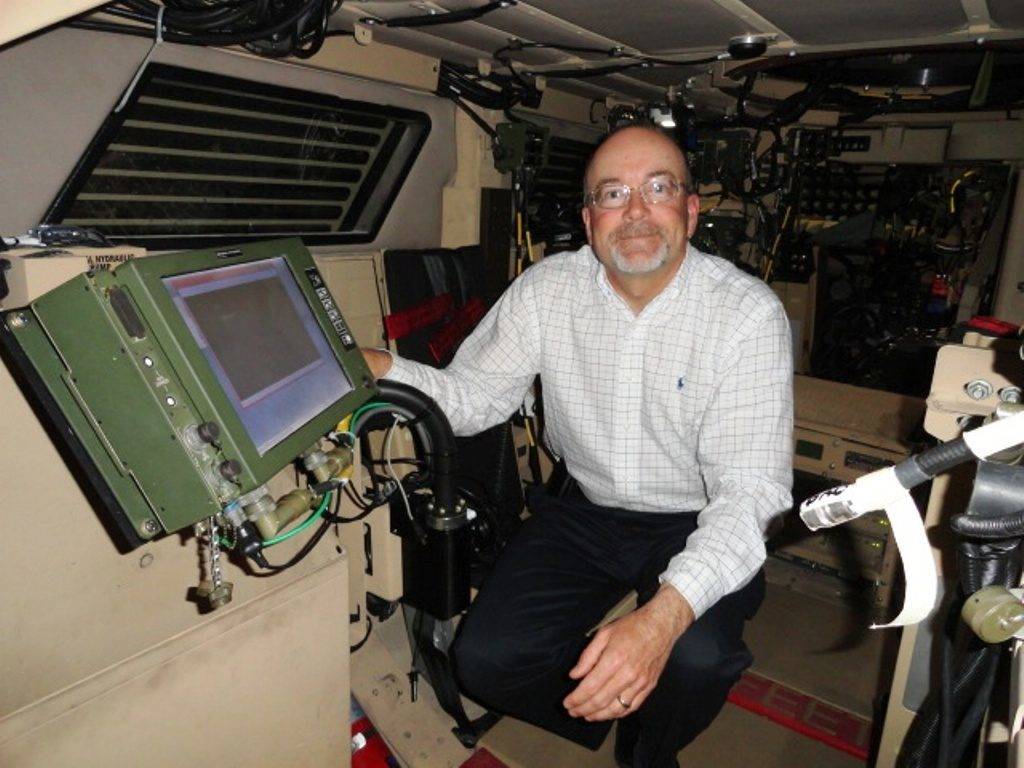
Recent finalist for the 2014 Samuel J. Heyman Service to America Medals, Patrick DeGroodt, deputy product manager for Warfighter Information Network-Tactical (WIN-T) Increment 2, demonstrates the advanced mobile network capabilities of WIN-T Increment 2 integrated in this MaxxPro Mine Resistant Ambush Protected (MRAP) vehicle at the Aberdeen Test Center, Aberdeen Proving Ground, Md. in May 2014. (U.S. Army photo)
The technical name for one of the Army’s communications networks is Warfighter Information Network-Tactical Increment Two. But some soldiers prefer to call it their digital guardian angel. Another calls it the holy grail of communication. Now one of the creators of the Army’s WIN-T system is receiving prestigious recognition for his role in its creation. Patrick DeGroodt is Deputy Project Manager for the Department of the Army. He’s a Service to America medal finalist in the National Security and International Affairs category. He explained the creation process on In Depth with Francis Rose.
For his work on the WIN-T Program, Patrick DeGroodt was nominated for a Samuel J. Heyman Service to America Medal
Except from “Army Engineer Honored For Improving Battlefield Communications” by Pamela Wood, Baltimore Sun
Imagine a life without smartphones, without Skype, without Wi-Fi-enabled laptops.
Now imagine being a soldier in Afghanistan, patrolling remote valleys with only the most basic form of communication: A radio that can transmit only to other soldiers within your line of sight.
For a decade, Patrick DeGroodt and his colleagues labored to improve battlefield communications for U.S. troops. The result is the Warfighter Information Network-Tactical, or “WIN-T” — a secure mobile communications system that allows soldiers to place phone calls, use military computer programs and send videos and photos via email, all from a souped-up Humvee driving down a dirt road halfway across the world.
“We’ve put that all into a vehicle so the soldier carries it with him,” said DeGroodt, who works for the Army’s Program Executive Office Command Control Communications-Tactical, or PEO C3T, at Aberdeen Proving Ground.
WIN-T, which was first deployed into war zones in 2012, enables soldiers to maintain constant communication with supervisors at their command post. They can also contact other groups of soldiers in the field and can call for help if they come under fire or suffer an injury.
For his work, DeGroodt has been named a finalist for the Samuel J. Heyman Service to America Medal, awarded annually by the Washington-based Partnership for Public Service to honor excellence among federal workers. He is a finalist in the national security and international affairs category. The winner will be announced in September.
Lara Shane, a vice president with the Partnership for Public Service, said DeGroodt’s work is impressive.
“He has connected soldiers that are in harm’s way with commanders and connected them to the resources they need to survive,” she said. “It’s an incredibly difficult accomplishment and it’s an important one. He literally is saving thousands of lives.”
DeGroodt, who has worked as a civilian for the Navy and the Army for 30 years, described his job as rewarding.
“The work I do helps soldiers,” he said. “There’s a real feeling of helping the country.”
Read the full story at : Pamela Wood, “Army engineer honored for improving battlefield communications,” Baltimore Sun, 7/10/2014

